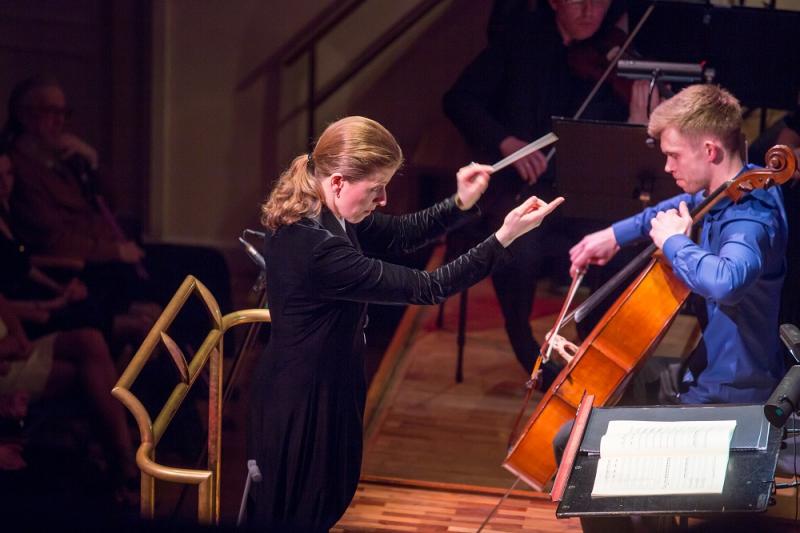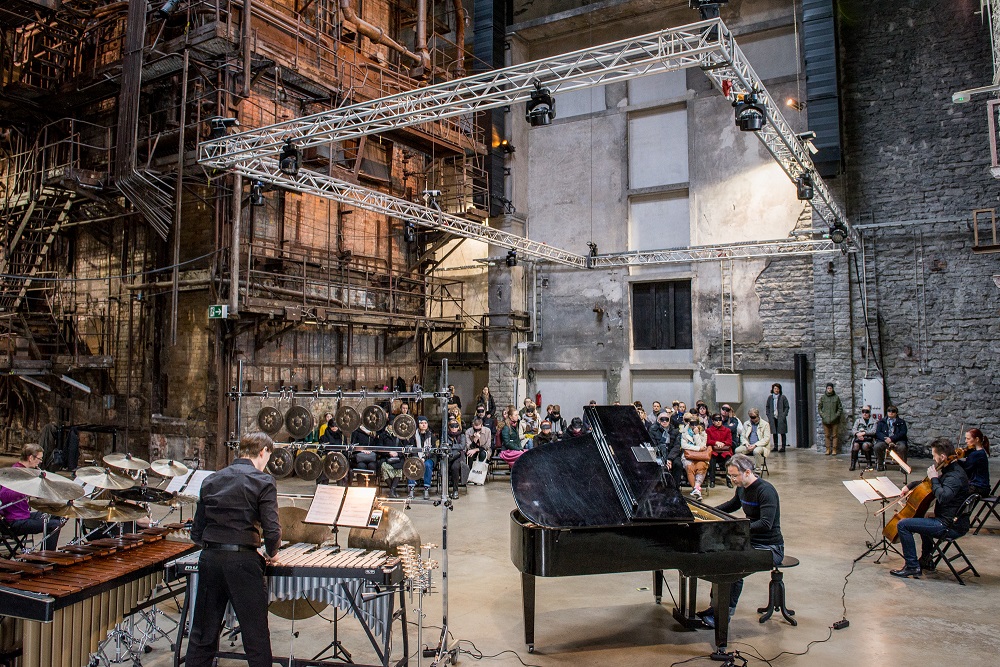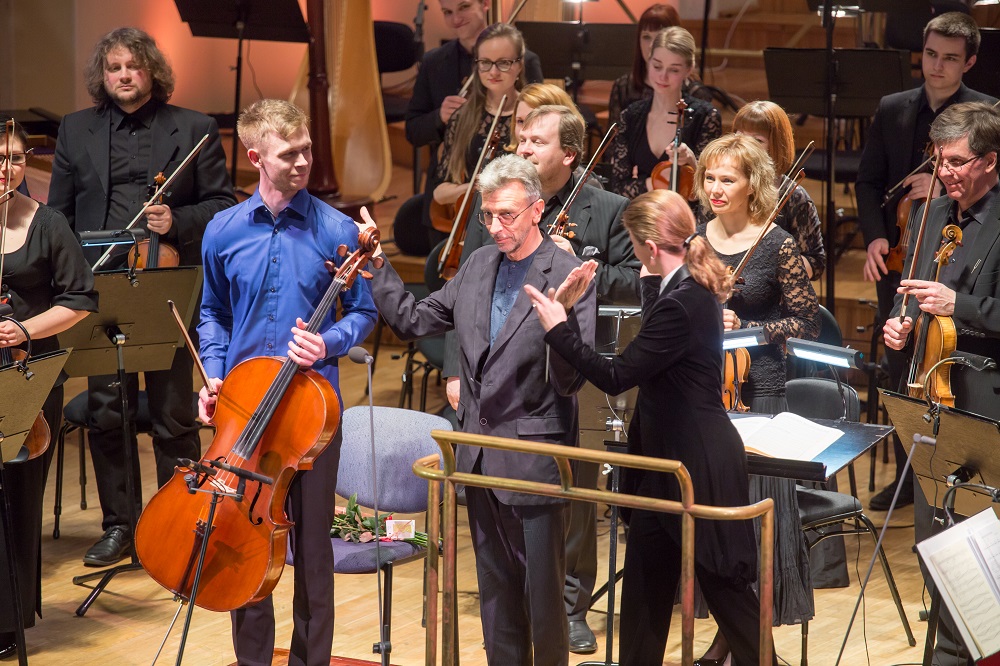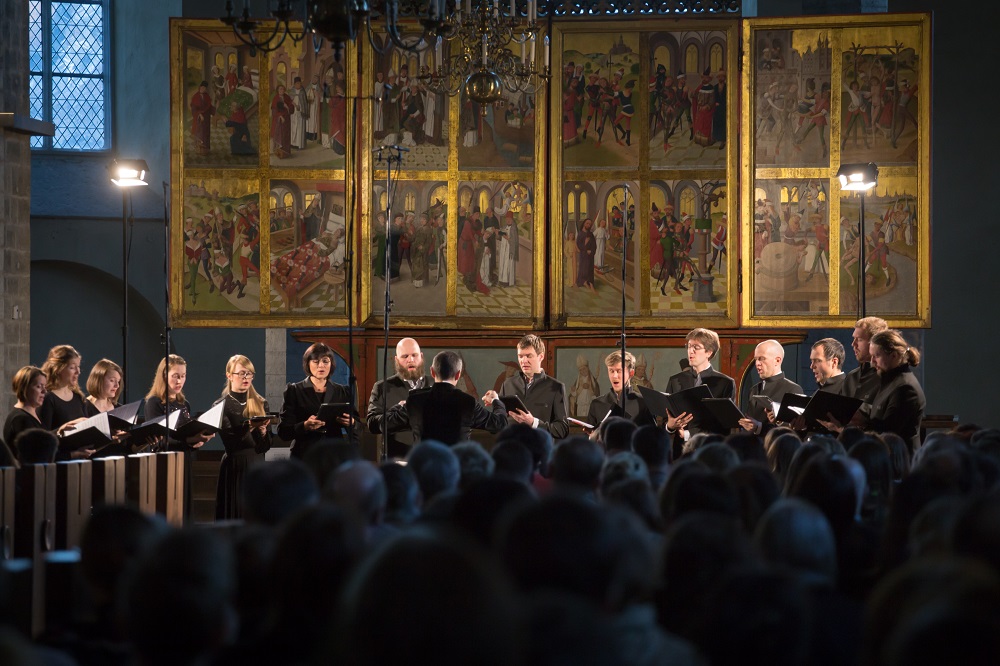theartsdesk in Tallinn: From Dusk to Black at Estonian Music Days | reviews, news & interviews
theartsdesk in Tallinn: From Dusk to Black at Estonian Music Days
theartsdesk in Tallinn: From Dusk to Black at Estonian Music Days
Imaginative brilliance in a spectacular showcase for thriving new music scene

Many other top Estonian musicians, performing among other works 30 premieres of music by their compatriots in just over a week, might have been equally deserving candidates for the lead image. But perhaps an even more appropriate image might have been a black rectangle.
For "Obscure Avenues" curated by Taavi Kerikmäe, 40 or so of us were put on a bus, asked to don tight eye-masks and driven to an "unknown destination". As invisible, gentle hands - they turned out later to have been those of dancers from the Estonian National Ballet and trained guides for the blind - led us and linked our arms up stairs and down, I sensed from the vastness of the space that this had to be the massive former power plant that is now Tallinn's Kultuurikatel or Cultural Hub (pictured below). But we never got to unmask and see it. Such an imaginative scale could not be realised in the UK. Health and safety rules must be underlined even when – as at the Royal Festival Hall last night for an extraordinary performance of Georg Friedrich Haas’s in vain - you're sitting safe in your seat and about to experience two batches of (not quite total) blackout amounting to a mere 22 minutes.  Led forward through the former industrial complex's seemingly endless spaces, we were assailed by ghost-train sound; crouching on pallets, we were surrounded by electronics. Finally the hands seated us to listen all the more intently to a bewitching new work - woodwind and percussion well to our right, piano central, strings far left (pictured above - as we never saw it - by Rene Jakobson). This turned out to be festival co-director Helena Tulve's Heart of the Earth. She told me at a gathering for writers and composers later that day - details of the event to be kept secret from the ones who were going on the later trail - that it moved her to tears to see us so helpless yet attentive. Two sensations may be worth noting: one, that I was rigid with tension until I learned to trust the guides; the other, that as we stood in what was still obviously sunlight with a cold east wind blowing in our faces, I thought with surprising tearfulness of that scene in King Lear where Edgar leads his blind father Gloucester upwards to what he tells him is the edge of Dover cliff, encouraging him to fall to the ground and not to his death.
Led forward through the former industrial complex's seemingly endless spaces, we were assailed by ghost-train sound; crouching on pallets, we were surrounded by electronics. Finally the hands seated us to listen all the more intently to a bewitching new work - woodwind and percussion well to our right, piano central, strings far left (pictured above - as we never saw it - by Rene Jakobson). This turned out to be festival co-director Helena Tulve's Heart of the Earth. She told me at a gathering for writers and composers later that day - details of the event to be kept secret from the ones who were going on the later trail - that it moved her to tears to see us so helpless yet attentive. Two sensations may be worth noting: one, that I was rigid with tension until I learned to trust the guides; the other, that as we stood in what was still obviously sunlight with a cold east wind blowing in our faces, I thought with surprising tearfulness of that scene in King Lear where Edgar leads his blind father Gloucester upwards to what he tells him is the edge of Dover cliff, encouraging him to fall to the ground and not to his death.
Other events belonging more to the phenomenal than to the numinous world were similar to my experiences of last year’s festival, but with subtle differences. There were still more women composers on the programme, and another female Estonian conductor, Kristiina Poska, following last year’s Anu Tali to take charge of the Estonian National Symphony Orchestra for the annual EMD concert in Tallinn’s main hall. And the profound, harrowing heart of that big programme, as in 2016, was also a symphony by Lepo Sumera, who died tragically young just before his 50th birthday in 2000, confirming that this was indeed one of the major symphonists of late 20th-century music - the strongest, surely, alongside Alfred Schnittke’s First and Third and Adams' three-movement symphonies in all but name. Poska kept a steely grip on Sumera’s swivelling between violent thrashes and the eerie bendings of the three slow movements in the Fourth Symphony, "Serena borealis". The last had all the burnt-out haunting of the Epilogue to Vaughan Willams’ Sixth, leaving the full house stunned before it erupted into wild cheering, bringing back Poska again and again to the platform. Here’s proof that Sumera could be a powerful calling-card for Estonian orchestras on tour.
Poska kept a steely grip on Sumera’s swivelling between violent thrashes and the eerie bendings of the three slow movements in the Fourth Symphony, "Serena borealis". The last had all the burnt-out haunting of the Epilogue to Vaughan Willams’ Sixth, leaving the full house stunned before it erupted into wild cheering, bringing back Poska again and again to the platform. Here’s proof that Sumera could be a powerful calling-card for Estonian orchestras on tour.
Another unquestionable spell-binder was Erkki-Sven Tüür’s Cello Concerto of 1996. Tüür (pictured above between Sink and Poska), now regarded as Estonia’s second major living composer after the 81-year-old Arvo Pärt, had been doubtful about allowing its performance in a festival of what he thought should be very recent works. But when he heard young Estonian cellist Theodor Sink play - and in the performance he did so from memory - he changed his mind. Sink gave the unusual form a powerful momentum, but there is no conventional solo domination; Tüür’s drama needs teamwork of the highest order, and it led to a two-minute silence at the end. Sink held it, we later learned, in tribute to his mother, who had died the previous week.
 Three other works, and a recorded preview of a fourth, in a packed programme enriched its dimensions. I long to hear Black Mirror by Toivo Tulev, this year’s winner of the LHV Bank and Estonian Composers Union Prize "Au-tasu"; a fascinating excerpt revealing its extraordinary vocal writing prefaced the prize-giving. Last year’s composer of choice, Liisa Hirsch (pictured right with Poska by Peeter Langovits), had her new work Threshold premiered at the concert - an incandescent evolutionary saga, short in length but epic in feel - while the first performance of Timo Steiner’s And then leave everything you’ve got and go… for piano and (eventually) orchestra had a spectral playfulness unlike anything else on the programme. It baffled and annoyed the ladies sitting next to me, who took everything else in their stride.
Three other works, and a recorded preview of a fourth, in a packed programme enriched its dimensions. I long to hear Black Mirror by Toivo Tulev, this year’s winner of the LHV Bank and Estonian Composers Union Prize "Au-tasu"; a fascinating excerpt revealing its extraordinary vocal writing prefaced the prize-giving. Last year’s composer of choice, Liisa Hirsch (pictured right with Poska by Peeter Langovits), had her new work Threshold premiered at the concert - an incandescent evolutionary saga, short in length but epic in feel - while the first performance of Timo Steiner’s And then leave everything you’ve got and go… for piano and (eventually) orchestra had a spectral playfulness unlike anything else on the programme. It baffled and annoyed the ladies sitting next to me, who took everything else in their stride.
Audiences were of all ages and astonishingly attentive. EMD always extends the possibilities of venues in Tallinn’s huge old town. Last year I heard no performances in its chief gem, St Nicholas’s Church, rebuilt after bombing in the Second World War to be a museum for Estonia’s finest religious art. The two choral concerts this time took place at either end of the main church, with the choruses respectively in front of Lübeck master Hermen Rode's altarpiece (pictured below by Peeter Langovits) and the six-armed brass candelabrum of 1519. It was a revelation to hear Vox Clamantis under its enterprising conductor Jaan-Eik Tulve for the first time, though the Estonian Philharmonic Chamber Choir and Kaspars Putniņš impressed more consistently than they had in 2016 with a clever alternation of tenebrous settings by Estonian and other composers. The opening concert of the main festival – a "mini-EMD" had been running for the preceding three days, organised by high-school students – officially began on a spiritual high with Galina Grigorjeva’s new seven-movement Vespers. (Its prelude, drawn from variously pitched crystal bowls by the deep-thinking Tulve, was a marvellous Evensong meditation.) Having been impressed by the CD recorded in the same church featuring Grigorjeva's even more amazing setting of poems in English by Joseph Brodsky, I did wonder where the “real” Grigorjeva was to be found. If anywhere, surely in the strange writing and piercingly high soprano lines of “Blessed Is the Man” and a very personal setting of the Nunc Dimittis rather than the flanking imitation of Gregorian and Orthodox chant. Born in Ukraine but based in Estonia, Grigorjeva deserves to be seen in the same hypnotic light as Pärt, two of whose settings for the Russian Orthodox canon of repentance provided a sobering finale.
The opening concert of the main festival – a "mini-EMD" had been running for the preceding three days, organised by high-school students – officially began on a spiritual high with Galina Grigorjeva’s new seven-movement Vespers. (Its prelude, drawn from variously pitched crystal bowls by the deep-thinking Tulve, was a marvellous Evensong meditation.) Having been impressed by the CD recorded in the same church featuring Grigorjeva's even more amazing setting of poems in English by Joseph Brodsky, I did wonder where the “real” Grigorjeva was to be found. If anywhere, surely in the strange writing and piercingly high soprano lines of “Blessed Is the Man” and a very personal setting of the Nunc Dimittis rather than the flanking imitation of Gregorian and Orthodox chant. Born in Ukraine but based in Estonia, Grigorjeva deserves to be seen in the same hypnotic light as Pärt, two of whose settings for the Russian Orthodox canon of repentance provided a sobering finale.
Pärt’s unique presence hung over an unexpected bonus, a visit arranged to the site on the Lohusalu peninsula to the west of Tallinn where work has just begun on the construction of the Arvo Pärt Centre. The winning design chosen from a rigorous competition held in Estonia, by Spanish architects Nieto Sobejano, 13 times modified, may now have more wood than glass to it, but it will still be integrated with the forest landscape near Pärt’s country retreat. There will be a chapel and a look-out tower, Pärt’s idea because the nearby Baltic Sea cannot otherwise be seen for the trees.
Such a visit of the deepest impact meant so much following-up: the watching of a quietly impressive documentary centred on those crucial sketchbooks by Dorian Supin, Even If I Lose Everything, a more than cursory Sumera survey and plenty of other listening. I’m still hoping Grigorjeva will send me a score of the Vespers; she apologised in Tallinn that she couldn’t release one at the time, as she’d noticed some mistakes. I can wait; Estonian time runs differently to that in other parts of the world, and if you succumb to it, the rewards will be profound indeed.
Explore topics
Share this article
Add comment
The future of Arts Journalism
You can stop theartsdesk.com closing!
We urgently need financing to survive. Our fundraising drive has thus far raised £49,000 but we need to reach £100,000 or we will be forced to close. Please contribute here: https://gofund.me/c3f6033d
And if you can forward this information to anyone who might assist, we’d be grateful.

Subscribe to theartsdesk.com
Thank you for continuing to read our work on theartsdesk.com. For unlimited access to every article in its entirety, including our archive of more than 15,000 pieces, we're asking for £5 per month or £40 per year. We feel it's a very good deal, and hope you do too.
To take a subscription now simply click here.
And if you're looking for that extra gift for a friend or family member, why not treat them to a theartsdesk.com gift subscription?
more Classical music
 Echo Vocal Ensemble, Latto, Union Chapel review - eclectic choral programme garlanded with dance
Beautiful singing at the heart of an imaginative and stylistically varied concert
Echo Vocal Ensemble, Latto, Union Chapel review - eclectic choral programme garlanded with dance
Beautiful singing at the heart of an imaginative and stylistically varied concert
 Scott, Irish Baroque Orchestra, Whelan, RIAM, Dublin review - towards a Mozart masterpiece
Characteristic joy and enlightenment from this team, but a valveless horn brings problems
Scott, Irish Baroque Orchestra, Whelan, RIAM, Dublin review - towards a Mozart masterpiece
Characteristic joy and enlightenment from this team, but a valveless horn brings problems
 Classical CDs: Voice flutes, flugelhorns and froth
Baroque sonatas, English orchestral music and an emotionally-charged vocal recital
Classical CDs: Voice flutes, flugelhorns and froth
Baroque sonatas, English orchestral music and an emotionally-charged vocal recital
 Kanneh-Mason, Britten Sinfonia, Shave, Milton Court - a grin and a big beaming smile
A pair of striking contemporary pieces alongside two old favourites
Kanneh-Mason, Britten Sinfonia, Shave, Milton Court - a grin and a big beaming smile
A pair of striking contemporary pieces alongside two old favourites
 theartsdesk at the New Ross Piano Festival - Finghin Collins’ musical rainbow
From revelatory Bach played with astounding maturity by a 22 year old to four-hand jazz
theartsdesk at the New Ross Piano Festival - Finghin Collins’ musical rainbow
From revelatory Bach played with astounding maturity by a 22 year old to four-hand jazz
 First Person: Manchester Camerata's Head of Artistic Planning Clara Marshall Cawley on questioning the status quo
Five days of free events with all sorts of audiences around Manchester starts tomorrow
First Person: Manchester Camerata's Head of Artistic Planning Clara Marshall Cawley on questioning the status quo
Five days of free events with all sorts of audiences around Manchester starts tomorrow
 Goldscheider, Brother Tree Sound, Kings Place review - music of hope from a young composer
Unusual combination of horn, strings and electronics makes for some intriguing listening
Goldscheider, Brother Tree Sound, Kings Place review - music of hope from a young composer
Unusual combination of horn, strings and electronics makes for some intriguing listening
 theartsdesk Q&A: composer Donghoon Shin on his new concerto for pianist Seong-Jin Cho
Classical music makes its debut at London's K-Music Festival
theartsdesk Q&A: composer Donghoon Shin on his new concerto for pianist Seong-Jin Cho
Classical music makes its debut at London's K-Music Festival
 Helleur-Simcock, Hallé, Wong, Bridgewater Hall, Manchester review - moving lyricism in Elgar’s concerto
Season opener brings lyrical beauty, crisp confidence and a proper Romantic wallow
Helleur-Simcock, Hallé, Wong, Bridgewater Hall, Manchester review - moving lyricism in Elgar’s concerto
Season opener brings lyrical beauty, crisp confidence and a proper Romantic wallow
 Kohout, Spence, Braun, Manchester Camerata, Huth, RNCM, Manchester review - joy, insight, imagination and unanimity
Celebration of the past with stars of the future at the Royal Northern College
Kohout, Spence, Braun, Manchester Camerata, Huth, RNCM, Manchester review - joy, insight, imagination and unanimity
Celebration of the past with stars of the future at the Royal Northern College

Comments
Thanks for a very moving